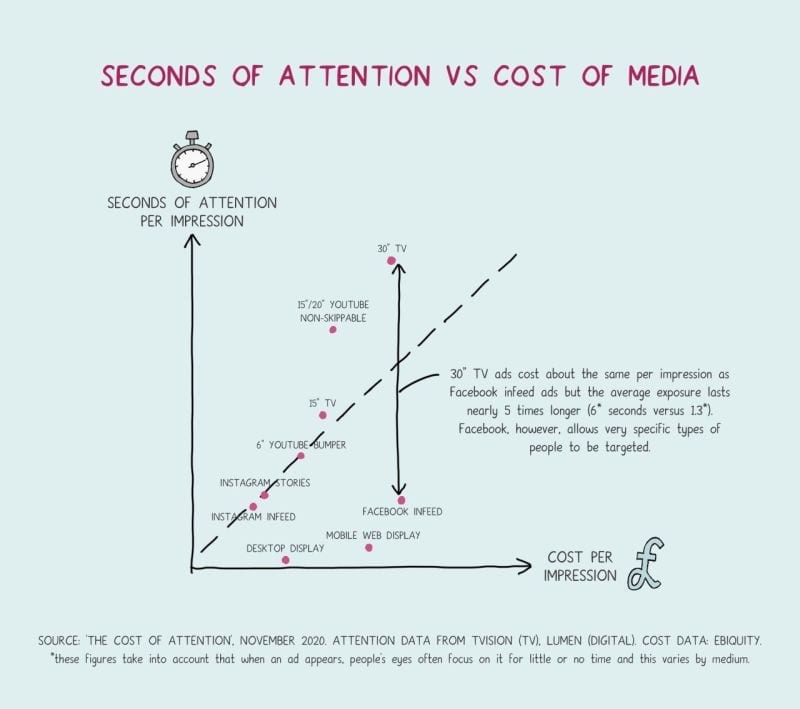This article is based on thinking and illustrations in The Smart Marketing Book (US: https://bit.ly/DJW1000; UK: lnkd.in/deayvyx).
1) Set the right budget
The right amount to spend on media depends on factors including your business’s objectives, its cash reserves and the competitive environment. Appropriate budgets can be set through detailed data analysis of previous advertising via modelling or econometrics (Market Mix Modelling). When data of this sort is not available, you can use benchmarks to guide you. For example:
- In October 2019, Gartner reported that businesses in North America and UK spend c.11% of revenue on advertising.
- The U.S. Small Business Administration (Caron Beesley, June 4th, 2012) recommends that small businesses making reasonable profits should spend 7-8% of revenue on marketing and advertising
- Between 2009 and 2019 Amazon spent c. 5% of net revenue on advertising and promotions.
So, the idea of spending between 5-10% of revenues on advertising might be a sensible starting point for budget discussions.
The next major consideration is share of voice (i.e., your media budget as a proportion of the total media spend across your key competitors). There is a clear relationship between a brand’s share of voice, relative to its share of market, and the chances of it growing or declining. Likewise, your brand’s share of voice compared to what it was previously also influences the chances of growth.
This means that your media budget needs to be considered in relation to what the competition is spending. A sensible default is to spend in line with your market share. If you’re planning for growth, you either need to spend more or ensure that your creative better than your competitors.
In markets with lots of activity, communications investment may be necessary just to maintain a brand’s sales. If this is the case, the communications can be considered effective if the brand’s sales can be maintained with a share of category spend similar to or lower than its share of market – although it can still be difficult justifying the investment to the CFO.
In fact, brands that spend on an on-going basis are likely to lose out financially in the long term if they stop spending for a while and it can take a long time for sales to recover once spend returns to normal. The illustration below, produced by D2D limited highlights the issue.
2) Be clear on the role of your communications
There are few brands that would not benefit from media investment but the role it should play depends on the brand’s life-stage.
Be clear on what you are trying to achieve with your communications before deciding on channels and messaging.
3) Chose the right types of media
The types of media that will be provide the best return on investment depends on how strong your user-experience is and on how much consumers care about their choice of brand when making a purchase decision. The matrix below can help you identify which types of media to prioritise.
If you’re clear on the types of media you need, you then need to identify which specific channels to invest in. This decision should be based on which channels:
- Offer the most cost-effective way to reach the brand’s broad target audience in an impactful way.
- Are right for the brand, given its desired positioning and imagery (e.g. Extreme sports sponsorship fits well with Red Bull)
- Help bring the creative idea alive (see examples below)
Identifying channels that offer a cost-effective way to reach your brand’s target audience in an impactful way requires a number of factors to be considered:
- The cost per impression
- The impact per impression
- How precisely your brand’s audience can be identified and targeted
- What proportion of your brand’s target the channel would be able to reach
The graph below illustrates the degree to which media channels can vary on some of these dimension so it’s worth obtaining as much data as you can before deciding which channels to prioritise.
4) Combine Brand Building and Sales Activation
When choosing media channels, it can be helpful to consider the two complementary roles they can play. Media can create interest and credibility for a brand by building mental associations that last for years – a concept called brand development. These make people more predisposed to the brand but may not be enough to deliver sales on their own. People are bombarded with so much marketing that it is often necessary to remind consumers of the brand close to the purchase decision and bring its associations to the fore so they can work their magic – i.e. activation. This is why an effective combination of long-term brand development media and short-term activation media is widely used. In other words, brand-building media put the ball in the vicinity of the goal, and activation media put it in the back of the net. An analysis by Les Binet and Peter Field (see The Long and the Short of it, IPA) indicates that a 60:40 split in media spend in favour of brand-building advertising produces the best results on average (although the optimum ratio for your brand will depend on many things such as the category, historical investment in brand, strength of competitors and creative quality of the ads you are using)
5) …











